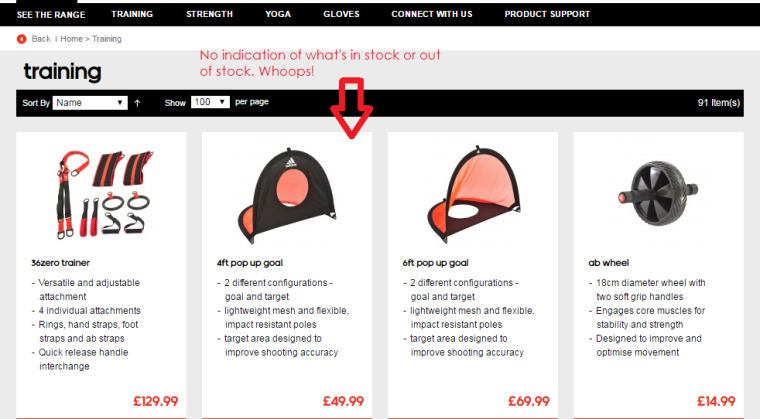While recently writing an audit for an e-commerce company, I noticed that a lot of the usability testers ‘pogostick’—technical slang for bouncing back and forth between pages, usually category pages and product detail pages. This happened because the inventory status of the items wasn’t listed on the category page. Users would go to product listings that had no inventory available and, as you can imagine, they would bounce back to the category page to try something else. Sometimes this second attempt also would come up dry.
Needless to say, the conversion rates were suffering. (See seven common conversion mistakes you might be making.)
The company I was auditing is far from alone in having this problem. While browsing some Magento cart e-commerce sites, I found that Adidas has the same problem:
 This product detail page shows they’re out of stock, but why didn’t they tell me on the category page?
This product detail page shows they’re out of stock, but why didn’t they tell me on the category page?Adidas’ pop up goal is out of stock, yet I had no idea when browsing the category page (second screenshot). And to make matters worse, as you’re scanning in frustration for the ‘add to cart’ button, you slowly realize it’s nowhere to be found. And in small, barely noticeable script there’s a notice that the product is out of stock. Well, why the heck show it to me in the category page then??
 The category page didn’t tell me whether a product was in stock or not. This is a classic cause of pogosticking behavior—a lack of message match.
The category page didn’t tell me whether a product was in stock or not. This is a classic cause of pogosticking behavior—a lack of message match.Visitors get frustrated when they encounter out-of-stock products and, even beside out-of-stock products, there are a range of similar problems in the move from category page to product detail page. Many of these issues can cause pogosticking behavior.
Pogosticking can happen not just when a visitor bounces back and forth between a category page and multiple product pages. It can occur between any two pages on a site, such as a homepage and category pages. The underlying issue is when something promised on an earlier page is not shown on the later page, or where the earlier page omits to tell you something that would influence your decision to click through.
Besides inventory issues, here’s a non-comprehensive list of information that might be missing on the higher-in-the-hierarchy page:
- Price
- When the product becomes available for purchase
- Sizes, colors, and other attributes that customers use to define your product. These will vary by industry
- Review summary
- Who’s selling and fulfilling the order (relevant to sites operating marketplaces where third parties sell their own goods (e.g. Amazon, eBay, Etsy, and dozens more)
So what can you do if your visitors are pogosticking? What’s the solution?
- First of all, give them the necessary information on the category or higher-level page. For example, eliminate uncertainty by including the price and key attributes in the product detail excerpts appearing on category pages.
 This category page on travel site Mindware Dental Seminars states neither the price nor the trip type of each product. This can increase pogosticking.
This category page on travel site Mindware Dental Seminars states neither the price nor the trip type of each product. This can increase pogosticking. - Hide out-of-stock products at the end of your category page, or on the last of your paginated-navigation pages. Why mention something that people can’t buy? Magento’s extensions marketplace includes a few options that’ll automate this for you. Just search ‘out of stock’.
Hiding out-of-stock products in this way can be beneficial not just to your conversion rate, but also to your SEO. Artios, a math-based SEO agency, found that out in a case study where they sculpted PageRank away from low-engagement pages—thanks to their math software—and saw a 208% increase in SEO traffic. - Review your product’s key attributes and determine which of them appear on your category pages and which do not. For example, the hotel industry might look at the number and size of beds in a room as well as amenities. Look at competitors’ sites and take note of the exact attributes they specify in their category pages’ product excerpts.
- Run usability tests on your site. Here’s how to do usability testing for up to 70% off. That way you can discover such mistakes. And once you’ve changed the excerpts, you can run another round of usability tests to check if you’ve fixed the problem successfully. What’s nice about this qualitative approach is that it works even if your traffic isn’t enough for a/b testing!
Have you seen pogosticking behavior on your site? If so, between what pages and what information was missing?
Did the visitors’ pogosticking hurt the add to cart conversions? Did you measure it in an A/B test, usability test, or another way?
Please comment with your thoughts and experiences below. I’d love to read and respond to you. 🙂
Image Credits
Featured Image: Pixabay
All screenshots by Gab Goldenberg. Taken April 2016.





